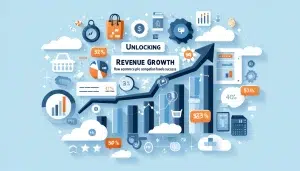Essential pricing strategies are a fundamental yet often overlooked aspect of managing a successful e-commerce business. They are critical in optimizing revenue and enhancing sales volumes, particularly as market dynamics evolve. In 2024, with the competitive landscape of e-commerce continuing to grow, adopting effective pricing tactics becomes increasingly crucial.
This article will explore essential pricing strategies that improve your online store’s performance and profitability. You will learn how to understand their customer base, monitor competitive pricing, implement dynamic repricing, and continuously test their pricing structures. By mastering these strategies, e-commerce store owners can better position their businesses for success in a rapidly changing digital marketplace.
6 Ways to Boost Essential Pricing Strategies in 2024
1. Understand Your Customer Base
Before implementing essential pricing strategies, e-commerce businesses must deeply understand their customer base. Identifying your customers’ preferences and buying habits forms the backbone of any successful pricing strategy. This initial step not only informs how you should price your products but also helps customize marketing efforts to meet the needs of your target audience better.
Here’s how to effectively gather and use this customer information:
- Demographics: Collect data on age, gender, income level, and location. For example, luxury products might be priced higher for high-income demographics, while value-for-money products might appeal more to cost-conscious segments.
- Online Behaviors: Analyze how your customers interact with your website and products. Use analytics tools to track their journey, from the landing page to purchase. This information can reveal which products are more appealing and at what price points.
- Social Platforms: Determine where your customers spend their time online. Suppose your target audience is predominantly active on Instagram rather than Facebook. In that case, you might focus your marketing and targeted advertising efforts there, which can also inform the type of products they are likely to purchase and their price sensitivity.
- Purchasing Habits: Observe and record the buying patterns of your customers. Are there specific times of the year they purchase more? Do promotions or discounts drive their decisions? This will help in setting prices that maximize sales during peak buying times.
By gathering and analyzing this information, you can develop a pricing strategy that resonates with your target audience, potentially leading to increased customer loyalty and higher sales volumes. Tools like customer relationship management (CRM) software can be instrumental in collecting and organizing this data efficiently.
2. Engage Through the Right Channels
Engaging with customers through the right channels is crucial when implementing essential pricing strategies in e-commerce. This tactic enhances your brand’s perception by actively connecting with your target audience on the most engaged platforms. Here’s how to optimize engagement through various channels effectively:
- Identify Popular Platforms: Determine which social media platforms your target customers use most frequently. For instance, if your audience includes millennials or Gen Z, platforms like Instagram or TikTok might be more effective than LinkedIn.
- Tailor Content for Each Platform: Customize your content to suit each platform’s specific format and style. This might include high-quality imagery, influencer collaborations, and exclusive behind-the-scenes content to elevate brand perception for premium brands.
- Leverage Targeted Advertising: Use targeted ads to reach potential customers who have shown interest in similar products or fit your customer demographic. Tools like Facebook’s and Instagram’s advertising platforms allow you to narrow down your audience by detailed criteria, enhancing the effectiveness of your premium pricing strategy.
- Monitor Engagement and Adjust: Regularly analyze each platform’s engagement levels and sales conversions. This data will help you refine your approach, focusing more on channels that convert viewers into buyers and less on those that do not.
Using these targeted engagement strategies helps justify higher price points by elevating the perceived value of your products. Customers who see a robust and well-presented brand consistently across their preferred platforms are more likely to perceive its value as aligning with the premium pricing.
3. Monitor Competitor Pricing
Monitoring competitor pricing is crucial for any e-commerce business that wants to remain competitive in a crowded market. This strategic approach is vital for understanding how your pricing stands concerning others and making informed decisions to optimize your pricing strategies. Here’s how you can effectively monitor competitor pricing:
- Use Automated Tools: Implement automated price tracking tools like Pricefy to monitor competitor pricing changes in real-time. These tools can provide instant updates, helping you react quickly to market changes.
- Analyze Pricing Trends: Look for patterns in how competitors adjust their pricing—during specific seasons, sales events, or in response to market shifts. This helps predict future pricing trends and plan your pricing strategy accordingly.
- Benchmark Your Prices: Regularly compare your prices against your competitors to ensure your pricing remains competitive without undercutting your profit margins. This can help you strike the right balance between being competitively priced and maintaining profitability.
- Understand Pricing Impact: Monitor how changes in competitors’ pricing affect their sales volumes and market share. This insight can guide your pricing adjustments to compete better and capitalize on any shifts in consumer preferences.
By continuously monitoring competitor pricing with tools like Pricefy , you can stay ahead in the market, strategically adjust your prices, and enhance your competitive edge. These essential pricing strategies ensure you are never caught off-guard and always ready to offer compelling prices to your customers.
4. Stay Informed and Responsive
In the dynamic e-commerce landscape, keeping an eye on competitors’ pricing is crucial. The competition in e-commerce has intensified post-pandemic, as more businesses have moved online, consumers have grown accustomed to online shopping, and product comparisons have become more accessible and faster.
Automated tools like Pricefy.io can track competitor prices in real-time to stay competitive. These tools help you understand competitors’ strategies and anticipate their next moves, ensuring you’re never outpaced in pricing adjustments.
5. Implement Competitive Pricing
Implementing competitive pricing is a vital strategy for e-commerce businesses aiming to understand and leverage the impact of price changes on consumer behavior. This approach ensures that your pricing is appealing to consumers and strategically positioned against your competitors. Here are steps and examples of how to effectively implement competitive pricing:
- Market Research: Start with thorough market research to determine the pricing strategies of your direct competitors. For instance, if you’re selling consumer electronics, check the prices of similar gadgets across different online platforms to gauge the average market price.
- Pricing Software Tools: Utilize pricing software tools to help analyze and set competitive prices automatically. Tools like Pricefy.io allow you to monitor competitor prices in real time and adjust your pricing based on predefined rules.
- Price Sensitivity Analysis: Conduct price sensitivity surveys to understand how much your customers are willing to pay for specific products. This information helps set a price ceiling that customers are unwilling to exceed, ensuring you do not price yourself out of the market.
- Dynamic Pricing: Implement dynamic pricing strategies that adjust prices based on market demand, competitor prices, and other external factors. For example, during major sales events like Black Friday or Cyber Monday, dynamically adjust prices to stay competitive and attract more buyers.
- Evaluate and Adjust: Regularly evaluate the effectiveness of your competitive pricing strategy. Analyze sales data and customer feedback to understand if your pricing is hitting the right note. If necessary, adjust your strategy to meet consumer expectations and market conditions better.
By effectively implementing competitive pricing, you can enhance your market presence, attract more customers, and maximize sales, particularly during peak shopping. This strategic pricing improves visibility and positions your business as a customer-friendly choice in a competitive market.
5. Set Dynamic Repricing Rules
Dynamic repricing is a strategy that adapts your prices in real time to remain competitive under varying market conditions. Establish rules such as adjusting your prices to be a specific percentage lower than your main competitors during crucial sales periods or higher when your brand holds a distinct advantage. This tactic is beneficial during different seasons or promotional cycles where demand fluctuates, allowing you to maximize profitability while maintaining competitive pricing.
6. Continuously Test Your Pricing
Continuous price testing is essential due to constantly changing market conditions. This method involves experimenting with different price points to see how they influence customer behavior and sales outcomes. Regularly testing and analyzing the results helps identify the most attractive pricing for your products while ensuring alignment with customer expectations and market trends. This ongoing process aids in fine-tuning your pricing strategy to optimize market competitiveness and customer satisfaction.
Conclusion
Adopting these essential pricing strategies in 2024 is essential for e-commerce success. You can significantly enhance your revenue and market presence by understanding your customers, monitoring competitors, implementing competitive pricing, setting dynamic repricing rules, and continuously testing prices. Start integrating these tactics to see a notable improvement in your e-commerce performance.




